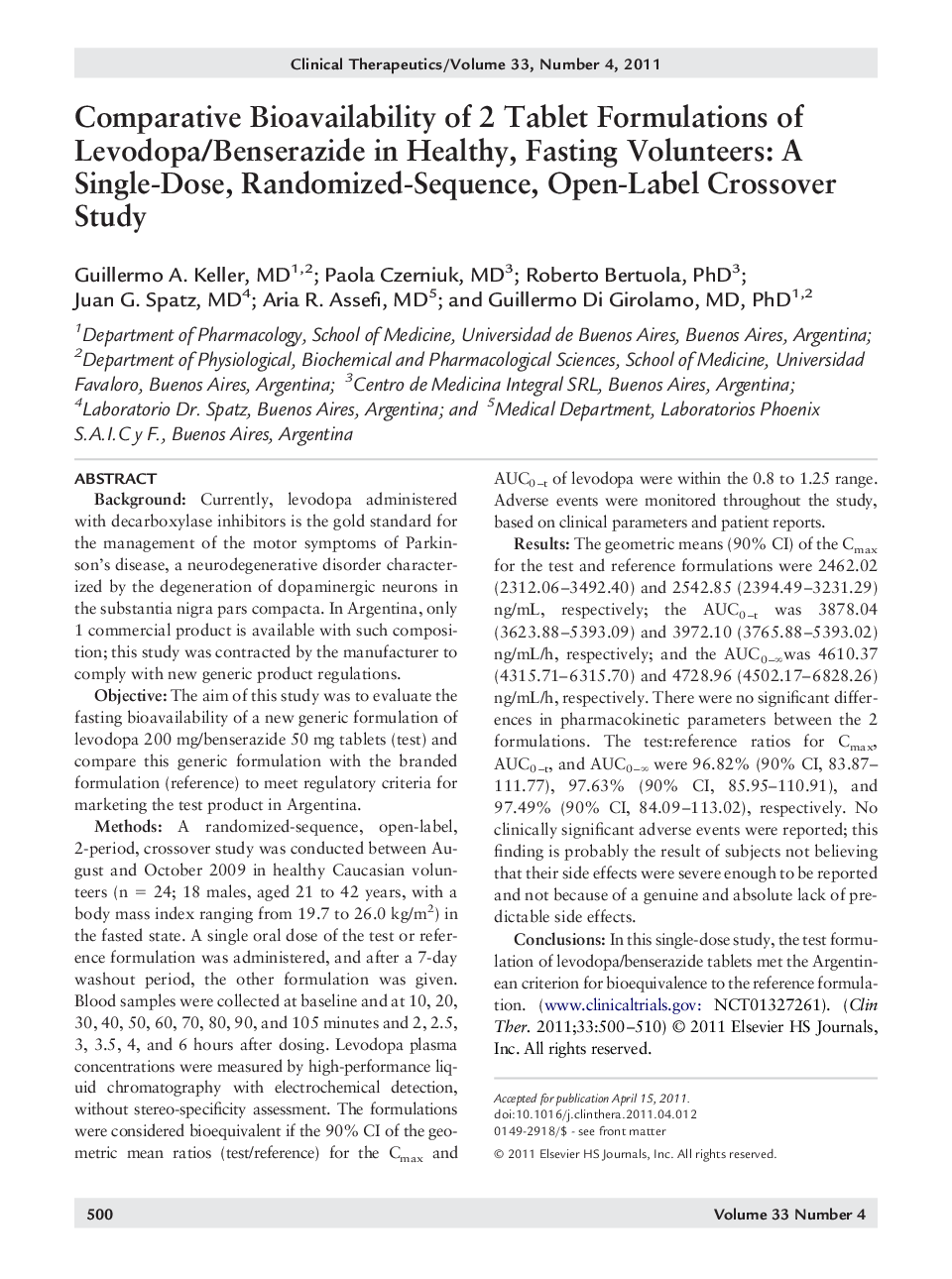| Article ID | Journal | Published Year | Pages | File Type |
|---|---|---|---|---|
| 2527636 | Clinical Therapeutics | 2011 | 11 Pages |
BackgroundCurrently, levodopa administered with decarboxylase inhibitors is the gold standard for the management of the motor symptoms of Parkinson's disease, a neurodegenerative disorder characterized by the degeneration of dopaminergic neurons in the substantia nigra pars compacta. In Argentina, only 1 commercial product is available with such composition; this study was contracted by the manufacturer to comply with new generic product regulations.ObjectiveThe aim of this study was to evaluate the fasting bioavailability of a new generic formulation of levodopa 200 mg/benserazide 50 mg tablets (test) and compare this generic formulation with the branded formulation (reference) to meet regulatory criteria for marketing the test product in Argentina.MethodsA randomized-sequence, open-label, 2-period, crossover study was conducted between August and October 2009 in healthy Caucasian volunteers (n = 24; 18 males, aged 21 to 42 years, with a body mass index ranging from 19.7 to 26.0 kg/m2) in the fasted state. A single oral dose of the test or reference formulation was administered, and after a 7-day washout period, the other formulation was given. Blood samples were collected at baseline and at 10, 20, 30, 40, 50, 60, 70, 80, 90, and 105 minutes and 2, 2.5, 3, 3.5, 4, and 6 hours after dosing. Levodopa plasma concentrations were measured by high-performance liquid chromatography with electrochemical detection, without stereo-specificity assessment. The formulations were considered bioequivalent if the 90% CI of the geometric mean ratios (test/reference) for the Cmax and AUC0–t of levodopa were within the 0.8 to 1.25 range. Adverse events were monitored throughout the study, based on clinical parameters and patient reports.ResultsThe geometric means (90% CI) of the Cmax for the test and reference formulations were 2462.02 (2312.06–3492.40) and 2542.85 (2394.49–3231.29) ng/mL, respectively; the AUC0–t was 3878.04 (3623.88–5393.09) and 3972.10 (3765.88–5393.02) ng/mL/h, respectively; and the AUC0–∞was 4610.37 (4315.71–6315.70) and 4728.96 (4502.17–6828.26) ng/mL/h, respectively. There were no significant differences in pharmacokinetic parameters between the 2 formulations. The test:reference ratios for Cmax, AUC0–t, and AUC0–∞ were 96.82% (90% CI, 83.87–111.77), 97.63% (90% CI, 85.95–110.91), and 97.49% (90% CI, 84.09–113.02), respectively. No clinically significant adverse events were reported; this finding is probably the result of subjects not believing that their side effects were severe enough to be reported and not because of a genuine and absolute lack of predictable side effects.ConclusionsIn this single-dose study, the test formulation of levodopa/benserazide tablets met the Argentinean criterion for bioequivalence to the reference formulation. (www.clinicaltrials.gov: NCT01327261).
